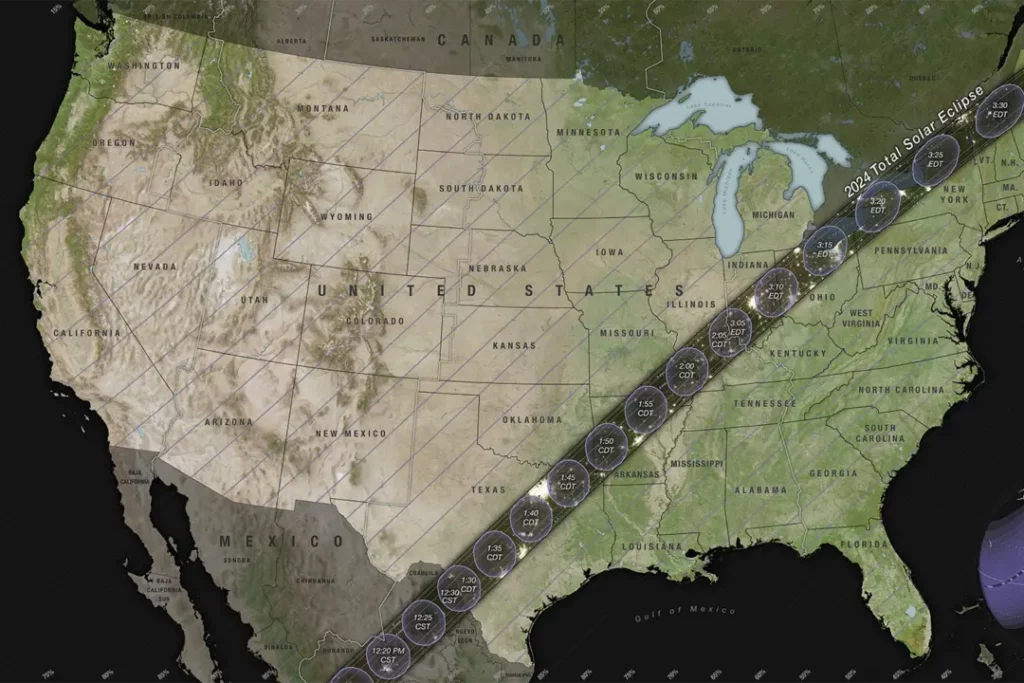
The Federal Aviation Administration (FAA) have issued a warning about potential disruptions in air travel due to the upcoming total solar eclipse on April 8.
The celestial event is set to cast a path of totality across 13 US states and according to the aviation agency is anticipated to impact air travel operations before, during, and after the eclipse.
You can unsubscribe any time. By subscribing you agree to our Terms of Use

Activist Post reports: The FAA indicated that the eclipse’s effects on U.S. airspace are anticipated between approximately 2:30 p.m. and 3:40 p.m. ET. At this time, some 32 million people in North America are expected to witness the rare event, which is anticipated to be the most-watched solar eclipse in history.
A total solar eclipse occurs when the new moon passes directly in front of the sun, completely blocking out sunlight and casting the moon’s shadow on the surface of Earth. The most recent total solar eclipse to happen on American soil was the Great American Eclipse in 2017.
A notice issued by the FAA to airmen emphasized potential impacts on air traffic and airports along the eclipse path from April 7 to April 10. Pilots and aviation personnel are advised to stay informed and prepared for possible disruptions.
In a statement, the FAA suggested that aircraft should ready themselves for potential airborne holding, reroutes, and departure clearance times that might be issued for all domestic IFR arrivals and departures during the eclipse.
Departing aircraft from airports along the eclipse path are “strongly encouraged” to coordinate their departure times as early as possible to assist fixed base operators with staging aircraft and alleviating ramp congestion.
“There may be a higher traffic volume than normal anticipated at airports along the path of the eclipse. Traffic should anticipate delays during peak traffic periods,” the FAA stated.
The agency cautioned that parking may be limited, particularly at small, uncontrolled airports. Delays with issuing IFR departure clearances might also happen.
“VFR departures may also expect delays for airborne pickup of IFR clearance within 50 NM either side of the path of the eclipse,” the FAA stated.
The eclipse will also impact or possibly prohibit aircraft from conducting practice approaches, touch-and-go operations, flight following services, and pilot training at airports during the event.
“Airmen should check NOTAMs carefully for special procedures/restrictions that may be in place at affected airports. Specific NOTAM procedures may be revised, and arrivals to some airports possibly restricted so please review NOTAMs frequently to verify you have the current information,” the agency advised.
Dubbed the “Great North American Eclipse,” the celestial event is expected to be more impressive than the one in 2017, lasting longer, being wider, and traversing more highly populated parts of North America.
On April 8, it will begin over the South Pacific Ocean and move across North America, spanning across Mexico, the United States, and Canada. The 2024 event will move in a different direction than the 2017 event, marking a cross on the United States.
The moon’s shadow will create a relatively narrow ribbon—the path of totality—of about 100 miles over Earth’s surface. To experience a 100 percent total solar eclipse, viewers should be located in this narrow band. This will reveal “the star’s outer atmosphere, called the corona,” according to NASA.
Totality will last for longer than four minutes in some parts of the United States.
 RSS Feed
RSS Feed













 March 25th, 2024
March 25th, 2024  Awake Goy
Awake Goy 

 Posted in
Posted in  Tags:
Tags: 
















